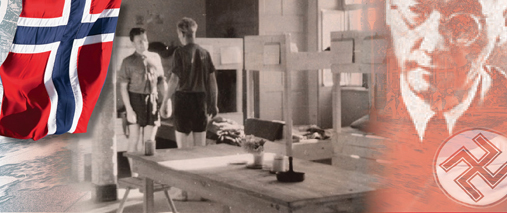Even Hitler was dissatisfied with the decision, not least because international protest was so strong, particularly in Sweden. It was Reichskommissar Josef Terboven in Oslo who took it upon himself to make this somewhat headstrong decision.
“Contrary to popular belief, the reason for the closure was not due to the fire in the university's Great Hall; it was the result of prolonged frustration on the part of the German authorities over the fact that the Nasjonal Samling party (NS) had failed in its attempts to implement its Nazification programme at the university.
Opposition to using academic authority to implement political projects was strong among teachers and students alike,” says historian Jorunn Sem Fure, who has the role of the university during World War II as one of her areas of specialisation.
1,250 students arrested
“The Nasjonal Samling party’s nazification programme for the University of Oslo was a total failure,” says researcher Jorunn Sem Fure. (Photo: Ståle Skogstad, UiO)
1,250 students were arrested when the university buildings were closed. 600 of these were subsequently released, while 650 were sent to Buchenwald and Sennheim concentration camps in Germany for military training by the SS. This happened during the autumn and winter months.
The Norwegian Student Society was quick to express its response to the occupying forces and the Riksrådet (national government) with the result that it was dissolved in September 1940. Apart from that, the university did not have a leading role early on in the resistance movement in the same way as the schools, the Church, the Supreme Court and the athletics community did, through staging protests, organising boycotts and resigning offices.
There were heated internal discussions among the professors over how they could best safeguard the academic freedom of the university while still continuing to operate. Some wanted to adopt a hard line against the Nazis; others argued that the best strategy would be to try to adapt to the situation so as to ensure that teaching and research activities could continue.
Disagreement over tactics
The disagreement that prevailed was mostly over tactics: “While there may well have been disagreements in certain situations during the war years, the fundamental idea itself was something on which all non-Nazis agreed: research and teaching activities should be free; admission to studies should not depend on political orientation,” wrote historian Sverre Steen in an account written after the war.
The closure of the university in 1943 put an abrupt end to all internal discussions. Many of the professors ended up in the “professors’ barracks” in the Grini concentration camp or made their way to Sweden.
“Through closing the university the regime revealed its true colours. This also represented a crushing defeat for the Norwegian Nazis’ attempt to win the academic community over. All impetus behind these attempts was lost,” says Jorunn Sem Fure.
When the occupying forces intervened in this way, it also reflected Terboven’s personal scepticism towards students and academic teachers. He did not believe that a majority of this group would ever embrace the Nazi ideology. His swift action ran entirely contrary to the Nazis’ wish to win over new leaders to help them achieve their political and national objectives.
Intensified battle
Jorunn Sem Fure is convinced that the German intervention in the university’s affairs spurred students who until then had not been particularly active to become more engaged in fighting the occupying forces.
Those who were sent to Germany were to be trained to lead the new Nazi Norway. They were therefore treated relatively leniently in the concentration camp. German university teaching staff came here to give lectures on race theory and Germanic history, but these measures failed miserably.
The students returned as ardent anti-Nazi supporters, and many of them assumed leading roles in the post-war reconstruction of Norway.
Repelled
After the university was closed, the NS tried to reopen it for teaching and examinations, but without success. The Deans had not been removed, and one of the conditions they set for reopening was that the students should be allowed to return from Germany and that the teachers who had been arrested should be released. These were demands which the occupying forces were unwilling to meet. All attempts at establishing new departments for Nazi research purposes were repelled.
The closure contributed to strengthening the reputation of the University of Oslo as one of the resistance movement’s key arenas. The university had repelled repeated attempts to restrict academic freedom and had paid a high price for doing so.
